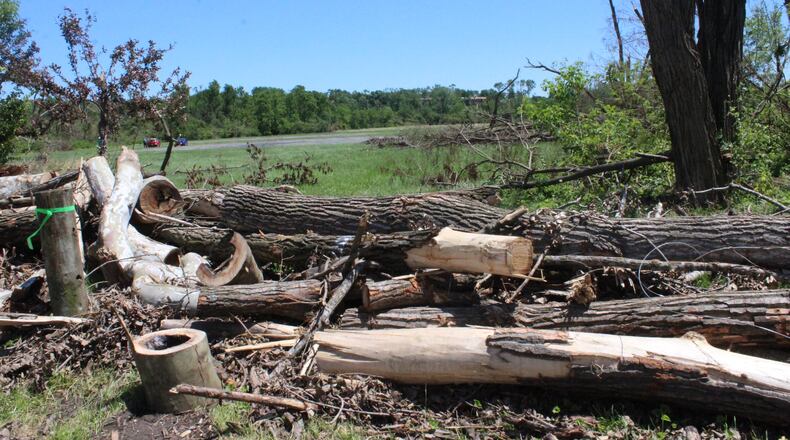“I had never seen destruction like that,” recalls Ron Bicknell, regional park manager for Five Rivers MetroParks. Homes, apartment complexes, businesses, all shattered. And trees for as far as the eyes could see, ripped from the ground or standing as bare trunks, stripped of branches and leaves.
Most of the formal gardens and buildings at Wegerzyn were spared, but trees along the mile-long loop trail were demolished. What was once a heavily wooded area with mature shade trees, where walkers could barely see the sun, was suddenly filled with light.
Credit: Chris Pion
Credit: Chris Pion
“It’s almost two different trail experiences now,” Bicknell says. “You’ve got the deep shade and the woods that lay wet, and then a lot of very open sun with a lot of shattered off trees.”
Bicknell remembers when he first saw the damage.
“After dark, we started hearing the emergency crews going down the road,” says Bicknell, who lives nearby but was unscathed. “My vision of a tornado was that it hits and goes on. I had no inkling that it would continue to grind for another 20 miles.”
He went to bed, imagining that Englewood MetroPark might have been hit and planning to go the next day. But as he sat drinking his coffee in the morning, a ranger called and said he should get to Wegerzyn as soon as he could.
The drive to Wegerzyn was surreal. He drove down I-75, but it was closed. He cut across on Benchwood, but his way was blocked by a church tower that had fallen across the road.
“So, I wound over to Dixie, and that’s when it started hitting home,” he says. “By the time I got down close to Frederick, it was just a wasteland.”
Dawn reveals tornado destruction
Eventually he arrived at Wegerzyn, and what he saw was heartbreaking. The tree line around the community gardens was gone, pieces of the boardwalk were shattered from fallen trees, picnic tables were blown up into trees, and the greenhouse system was shredded. Fences, gates, even trash barrels, needed repair and replacement.
“The first two days, we just had chippers and chainsaws trying to clean up the parking lot and the main part of the bikeway,” he says. “We didn’t even start delving back into the park until probably Thursday.”
The park was closed for three weeks, and electricity was out for at least two. Almost all MetroParks staff helped, including every chainsaw operator and chipper in the agency.
Chris Pion, now the chief of operations for Five Rivers MetroParks, noted that in the initial tornado response, staff hours totaled 1,419, almost $40,000 in staff time.
“Countless additional hours have been expended after the initial response, planning and implementing planting and habitat restoration projects,” Pion says. “Many of these projects have included others in the community and volunteer support.”
Although multiple MetroParks properties were in the tornadoes’ path, Wegerzyn was by far the hardest hit, with more than $80,000 in damage. And that does not count the trees and wildlife. “There was no damage estimate created to reflect these losses, but they were significant,” Pion says.
Trees and wildlife begin to recover
Today, many of the toppled trees remain where they fell. That’s in part because of the sheer magnitude of the damage. “It really wasn’t an option,” Bicknell says.
But more importantly, it’s part of MetroParks’ conservation philosophy.
“If you leave some of that thicket there, it provides cover for that successional growth that comes in,” Bicknell says. “We have made some efforts in planting trees in some areas, but natural succession is overtaking a lot of our efforts. A lot of our native species – hackberry trees, black locust trees -- those are coming up on their own pretty quickly.”
The next wave of trees – sugar maples, oak, hickory, tulip poplars and silver maples – are already coming back.
The damage also impacted wildlife, especially nesting birds.
“We haven’t seen barred owls in here since the tornado,” Bicknell says.
But the bald eagles seemed to have benefited. The high dead tree snags give them better perch to see than the previously wooded area. “They do hang out along the river, and we never used to see that,” he says. “They may have been there, but they were not as visible.”
And it’s been a boon for the pileated woodpeckers, who’ve had plenty of dead trees to tackle. Wood ducks, too, have found new homes in dead tree cavities.
And Wegerzyn has also benefitted through grants and an unexpected expansion.
A Clean Ohio land purchase, in coordination with the City of Dayton, paid to demolish heavily damaged apartment buildings next to Wegerzyn, Pion says. That land is now part of the Wegerzyn park, and work is underway to expand the trail through that area.
Five Rivers MetroParks also received $21,700 in donations and grants from the Arbor Day Foundation, State Farm and the Garden Club of America to plant seedlings at Wegerzyn — plants grown at Cox Arboretum MetroPark. Volunteers from the Garden Club of Dayton, State Farm and Chaminade Julienne helped. FEMA reimbursements for all MetroParks totaled more than $105,000.
Bicknell says it will take 25 to 30 years for the park to truly recover, but the healing is well on its way.
“Mother Nature does a pretty good job healing on her own,” Bicknell said.
Jana Collier is a member of the Five Rivers MetroParks Foundation Board. To learn about the foundation and how you can help, go to www.metroparks.org/about/foundations/
About the Author


